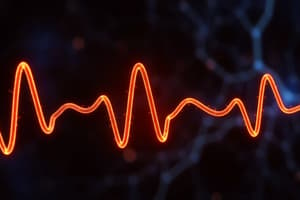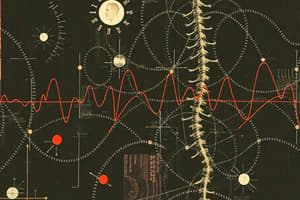Podcast
Questions and Answers
What specialized structures connect cardiac muscle cells to each other?
What specialized structures connect cardiac muscle cells to each other?
- Intercalated disks and desmosomes (correct)
- Aponeuroses and gap junctions
- Retinaculum and myofibrils
- Tendons and ligaments
In skeletal muscle anatomy, what is the significance of the origin?
In skeletal muscle anatomy, what is the significance of the origin?
- It is the part of the muscle that contracts
- It is always the longest attachment
- It is the attachment at the least mobile location (correct)
- It is where the muscle is innervated
Which term describes the part of the muscle located between the origin and insertion?
Which term describes the part of the muscle located between the origin and insertion?
- Retinaculum
- Aponeurosis
- Fascicle
- Belly (correct)
What is the role of agonist muscles?
What is the role of agonist muscles?
How are muscles named according to their orientation?
How are muscles named according to their orientation?
Which of the following statements about skeletal muscle attachments is correct?
Which of the following statements about skeletal muscle attachments is correct?
What is an example of a broad, sheetlike tendon?
What is an example of a broad, sheetlike tendon?
What defines an antagonist muscle?
What defines an antagonist muscle?
What initiates an action potential in the muscle fiber during neuromuscular transmission?
What initiates an action potential in the muscle fiber during neuromuscular transmission?
Which sequence of events best describes the muscle contraction process after the action potential reaches the presynaptic terminal?
Which sequence of events best describes the muscle contraction process after the action potential reaches the presynaptic terminal?
What occurs immediately after acetylcholine binds to its receptors on the sarcolemma?
What occurs immediately after acetylcholine binds to its receptors on the sarcolemma?
How does the action potential propagate along the muscle fiber?
How does the action potential propagate along the muscle fiber?
Which ion plays a crucial role in the release of acetylcholine from synaptic vesicles?
Which ion plays a crucial role in the release of acetylcholine from synaptic vesicles?
What triggers the release of calcium ions from the sarcoplasmic reticulum during muscle contraction?
What triggers the release of calcium ions from the sarcoplasmic reticulum during muscle contraction?
What is the first event that occurs when an action potential reaches a muscle fiber?
What is the first event that occurs when an action potential reaches a muscle fiber?
What effect does the entry of sodium ions (Na+) into the muscle fiber have?
What effect does the entry of sodium ions (Na+) into the muscle fiber have?
What is the role of Ca2+ in muscle contraction?
What is the role of Ca2+ in muscle contraction?
What must occur for cross-bridge cycling to continue?
What must occur for cross-bridge cycling to continue?
What happens when ATP binds to myosin during muscle contraction?
What happens when ATP binds to myosin during muscle contraction?
What is rigor mortis a result of?
What is rigor mortis a result of?
What is the primary function of the myosin heads during muscle contraction?
What is the primary function of the myosin heads during muscle contraction?
How does the sliding filament model explain muscle contraction?
How does the sliding filament model explain muscle contraction?
What is the role of ATP in muscle contraction?
What is the role of ATP in muscle contraction?
What occurs after the myosin heads bend during muscle contraction?
What occurs after the myosin heads bend during muscle contraction?
What type of muscle fibers are primarily found in the upper limbs?
What type of muscle fibers are primarily found in the upper limbs?
Which of the following processes helps convert ADP to ATP during muscle contraction?
Which of the following processes helps convert ADP to ATP during muscle contraction?
How long can muscle fibers store enough ATP to contract?
How long can muscle fibers store enough ATP to contract?
What process predominates when a muscle fiber is working strenuously after initial ATP stores are depleted?
What process predominates when a muscle fiber is working strenuously after initial ATP stores are depleted?
Which type of muscle fibers mainly utilize anaerobic production of ATP?
Which type of muscle fibers mainly utilize anaerobic production of ATP?
What substance is transferred to ADP to form ATP by creatine kinase?
What substance is transferred to ADP to form ATP by creatine kinase?
What is the primary role of the Ca2+ pump in muscle fibers?
What is the primary role of the Ca2+ pump in muscle fibers?
Which type of muscle fibers are more efficient at utilizing aerobic pathways?
Which type of muscle fibers are more efficient at utilizing aerobic pathways?
Which type of muscle is characterized as striated and involuntarily controlled?
Which type of muscle is characterized as striated and involuntarily controlled?
Which of the following is NOT a function of muscles?
Which of the following is NOT a function of muscles?
What is the term for the ability of a muscle to respond to a stimulus?
What is the term for the ability of a muscle to respond to a stimulus?
Which type of muscle is found in blood vessels and hollow organs?
Which type of muscle is found in blood vessels and hollow organs?
How much of the body weight is constituted by skeletal muscle?
How much of the body weight is constituted by skeletal muscle?
What property allows a muscle to return to its original length after being stretched?
What property allows a muscle to return to its original length after being stretched?
Which type of muscle is described as being attached to bones and under voluntary control?
Which type of muscle is described as being attached to bones and under voluntary control?
Which of the following is a primary function of skeletal muscle?
Which of the following is a primary function of skeletal muscle?
Flashcards are hidden until you start studying
Study Notes
Ion Channels and Action Potentials
- Action potentials trigger muscle fiber contraction via neuromuscular junctions.
- Acetylcholine is key for initiating action potentials in muscle fibers.
Neuromuscular Junction Function
- Each muscle fiber is connected to a motor neuron at the neuromuscular junction.
- Release of acetylcholine from the motor neuron stimulates action potentials in the muscle fiber, leading to contraction.
Muscle Contraction Process
- Action potential travels down the motor neuron to its terminal, opening Ca2+ channels.
- Ca2+ influx leads to acetylcholine release into the synaptic cleft.
- Acetylcholine binds to Na+ channels in the sarcolemma, generating an action potential along the muscle fiber.
Calcium Release and Muscle Contraction
- The action potential continues down T tubules to the sarcoplasmic reticulum, causing Ca2+ release.
- Ca2+ binds to troponin, moving tropomyosin and exposing myosin binding sites on actin, facilitating contraction.
Cross-Bridge Cycling
- Cross-bridge movement is essential for muscle contraction; one ATP molecule is needed for each cycle.
- Myosin heads bind to actin, bending and sliding actin past myosin, continuing as long as Ca2+ is present.
ATP and Muscle Contraction Energy
- ATP supplies energy for muscle contractions, releasing energy during its conversion from ATP to ADP + Pi.
- Myosin heads store energy in ATP; absence of ATP, as in rigor mortis, prevents cross-bridge release.
Types of Muscle
- Skeletal muscle: striated, attached to bones, and under voluntary control.
- Cardiac muscle: striated, located in the heart, and involuntarily controlled.
- Smooth muscle: non-striated, found in blood vessels and hollow organs, and involuntarily controlled.
Functions of the Muscular System
- Essential functions include movement, maintaining posture, respiration, body heat production, communication, constricting organs/vessels, and heart contraction.
Functional Properties of Muscles
- Contractility: ability to shorten forcefully.
- Excitability: capacity to respond to stimuli.
- Extensibility: ability to stretch beyond normal resting length.
- Elasticity: ability to recoil to original length after stretching.
Skeletal Muscle Anatomy
- Constitutes about 40% of body weight; many muscles attach to the skeletal system.
- Fast-twitch fibers primarily found in upper limbs for rapid movements.
Energy for Muscle Contractions
- ATP is used by myosin heads, Na+/K+ ATPase, and Ca2+ pumps.
- Muscle fibers have enough ATP for approximately 5-6 seconds of contraction; thereafter, ATP must be produced.
ATP Production Mechanisms
- ATP generated through four main processes: adenylate kinase conversion, creatine phosphate transfer, anaerobic production during intense exercise, and aerobic production under normal conditions.
Muscle Fiber Characteristics
- Fast-twitch fibers excel in anaerobic conditions, while slow-twitch fibers utilize aerobic pathways.
- Lactate from fast-twitch fibers supports aerobic ATP production in slow-twitch fibers.
Cardiac Muscle Structure
- Cardiac cells interconnected by intercalated disks, allowing coordinated contractions.
Skeletal Muscle Attachment
- Tendons connect muscle to bone; aponeuroses are sheet-like structures.
- Origin refers to the attachment site, while insertion is the point undergoing most movement.
Muscle Naming Conventions
- Muscles named by location, size, shape, orientation of fascicles, and other anatomical features.
Studying That Suits You
Use AI to generate personalized quizzes and flashcards to suit your learning preferences.




